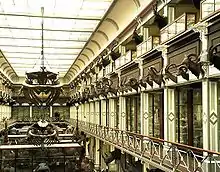Frederick Clarendon
Frederick Villiers Clarendon (c.1820 – 17 October 1904) was an Irish Architect noted for his design work on a number of large public buildings in Dublin, including the Natural History Museum and Arbour Hill Prison.[1]
Frederick Villiers Clarendon | |
|---|---|
 Interior of the Natural History Museum | |
| Born | C. 1820 Dublin, Ireland |
| Died | 1904 Dublin |
| Nationality | Irish |
| Alma mater | Trinity College, Dublin |
| Occupation | Architect |
| Practice | Board of Public Works |
| Buildings | National History Museum, Dublin |
Life
Frederick Clarendon was born in Dublin around 1820 and received a Bachelor of Arts at Dublin University in 1839. Directly after graduation he was employed by the Office of Public Works, where he would remain until his retirement in 1887. Clarendon died in Mountjoy Square, Dublin in 1904.[1]
Works
Clarendon's earliest major works focussed on Dublin's prison system. Arbour Hill Prison was redesigned in 1845 by Sir. Joshua Jebb with Clarendon acting as executive architect, and Clarendon was also co-designer of the "Criminal Lunatic Asylum" in Dundrum two years later. Clarendon oversaw the renovation and extension of the Royal Irish Academy's premises on Dawson Street between 1852 and 1854, as their existing Grafton Street location had become overcrowded.[2] Clarendon's most remembered work is Ireland's Natural History Museum on Merrion Street adjacent to Leinster House, known as the "Dead Zoo".[3][4] The Royal Dublin Society had been obliged to use a public architect in order to obtain treasury funding, and the building was taken over by the State in 1877. Today the Museum forms part of the National Museum of Ireland. Clarendon provided his services free of charge to design the Mariners Hall, Howth in 1867.[1] This then served as a Presbyterian Meeting House for over thirty years, services being conducted through the medium of Scottish Gaelic, the language of the immigrant seasonal fishermen of the village.[5]
See also
References
- "CLARENDON, FREDERICK VILLIERS". Directory Of Irish Architects, 1720-1940. Irish Architectural Archive. Retrieved 2009-05-28.
- Casey, Christine (2005). Dublin: the city within the Grand and Royal Canals and the Circular Road with the Phoenix Park. Yale University Press. p. 477. ISBN 0-300-10923-7. Retrieved 2009-05-28.
- Clerkin, Paul. "Natural History Museum, Merrion Square, Dublin". Architecture of Ireland. Archiseek. Archived from the original on 2008-11-20. Retrieved 2009-05-28.
- Hoque, Abeer (2006-05-27). "Notes on Dublin". The Daily Star. Retrieved 2009-05-28.
- O'Shea, Tom. "Illustrated Guide to Historical Malahide - Part II". Malahide Historical Society. Archived from the original on 2008-10-15. Retrieved 2009-05-28.